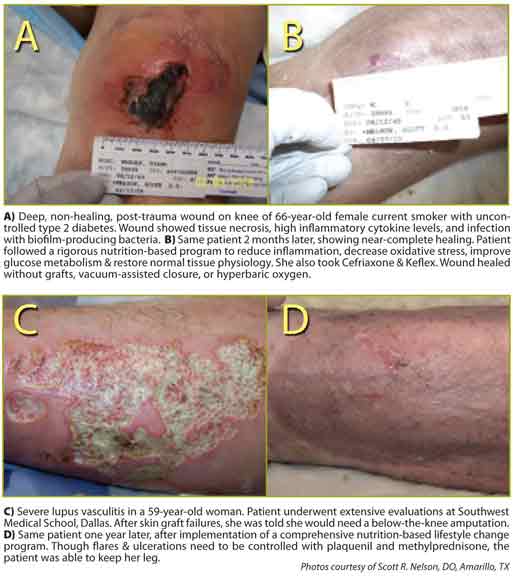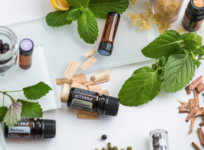Non-healing, chronic wounds cause tremendous suffering and debilitation. There’s a lot more that we as primary care physicians can do for patients who struggle with this problem if we understand that chronic wounds are very different from acute wounds, and require an entirely different treatment approach.
There are several different types of chronic wounds: pressure ulcers (aka “bed sores,” venous stasis ulcers, diabetes-associated foot and leg ulcers, wounds caused by radiation therapy, non-closing surgical wounds, to name a few. Many features distinguish these from acute injuries, but the most important common characteristic of nearly all non-healing wounds is a stubborn, underlying inflammatory state which blocks completion of the healing process.
As physicians, we can directly address some of the factors that inhibit closure and healing, such as excessive bacterial load, presence of dead tissue, deficiency of growth factors and circulatory issues. Other factors are related to the individual’s diet and lifestyle. Since we cannot intervene directly to change these, we need to make every effort to help patients understand the connection between the misery of their non-healing wound(s) and their lifestyle choices.
Occasionally, we will see a chronic wound in a healthy person, but far more often non-healing wounds are happening in unhealthy bodies. If we want the wounds to heal, we—and our patients—need to understand that we must work together to improve overall health. Many times this can be the difference between recovery and amputation—or worse.
Unearthing the Obstructions
My starting point with any non-healing wound is this simple question: Why hasn’t this particular wound healed properly? A healthy body is graced with exquisite mechanisms for healing damaged tissues, and for doing it quickly. If that’s not happening, there’s a reason. The first task is to try to uncover that reason.
When tissue is wounded, platelets immediately start to adhere to the defects in vessel walls and to release cytokines and platelet-derived growth factor. This triggers a cascade of events leading to release of yet more cytokines and growth factors, attracting fibroblasts to create a new matrix to repair the damage, as well as immune cells to keep bacterial counts down.
An initial surge of inflammation is a healthy part of the process of eliminating pathogens. But if there is an underlying pro-inflammatory state, or something causes the process to stall in this inflammatory phase, the result is non-healing.
In assessing these patients, consider issues such as hyperglycemia, low serum protein levels, continued mechanical stress (shear or pressure), vascular insufficiency, excess bacterial burden, the presence of autoimmune diseases or other conditions that might interfere with the wound healing process.
Of course it is important to debride any dead tissue and drain excessive fluid, which typically contains high levels of inflammatory mediators. Negative pressure (VAC) technologies, hyperbaric oxygen, bioactive skin substitutes, antibiotics and all the other standard tools of conventional wound care can help to a point. But often, these fail to give complete closure. This is the point at which many physicians simply give up, and accept that amputation is inevitable.
I believe this is precisely the point where we need to go back to that original question: Why is this wound not healing properly?
Often, the answer is that wound physiology is still altered. Hormone levels are disturbed, growth factors are depleted, biofilms may have been created by bacteria seeking a commensal relationship with the wound bed. In trying to treat chronic wounds we need to recreate, as far as is possible, the normal wound bed environment by putting back what should be there and by removing obstacles.
Nutritional Building Blocks
Poor wound healing often reflects insufficient intake of the basic nutritional building blocks of healthy tissue. The simplest starting point is to make sure protein and vitamin intake is sufficient. Researchers estimate that most people need 1.85 grams of protein per kilogram body weight (that’s 1.2 grams per pound) every day to effectively impact wound healing outcomes.
Vitamins C, E, A, Zinc and Iron are also important. At the very least, a patient with wound healing problems should take a natural multivitamin with these minerals. They should also take vitamin C at a dose of one gram (1000 mg) per day.
Patients on cortisone-like drugs (for MS, cancer, arthritis etc) need to up their intake of Vitamin A to at least 10,000 IU per day (8,000 IU per day if taken in the form of Beta Carotene). Oral zinc sulfate at a dose of 220 mg, thrice daily, has been shown to reduce healing time by as much as 43% for some wounds.
Amino Acid & Hormone Support
Arginine and glutamine are both very important nutrients for patients with non-healing wounds. Arginine increases synthesis of nitric oxide, a key vasodilator, thus improving circulation and oxygenation. Glutamine provides substrate for new tissue growth.
I like to have my patients take 30 g of L-glutamine, and 15 g L-arginine daily (unless they have a history of cancer, in which case arginine is contraindicated). If someone has a history of herpes/shingles, the arginine should be accompanied by 2 g of L-lysine. I’ve had good effects with a product called Juven (Abbott Labs), a combination of arginine, glutamine and hydroxy methyl butyric acid. Arginaid (Nestle Nutrition), which contains arginine, vitamins C, and E is also good. Both products are formulated for treatment of non-healing wounds, and come in a convenient powder form that patients mix into juice, water or smoothies.
It’s also a good idea for patients to take 1 g acetyl-L-carnitine, thrice daily, as it promotes fatty acid metabolism in the hypoxic cellular environment typical of chronic wounds. Coenzyme Q10, 150 mg, thrice daily, increases cellular energy production. To reduce free radical damage, I recommend alpha lipoic acid (ALA), 200 mg, thrice daily, and 3 g of omega 3 fatty acids.
These nutritional approaches were first pioneered by Lewis Clark, MD, who graciously shared his discoveries with me when I was struggling with how to treat nutritionally-depleted patients with chronic wounds.
Patients over age 40, a category that represents most people with chronic wounds, will usually require hormonal support. At the very least, think about giving 50 mg per day of DHEA, a hormone precursor, which can be decreased if the patient’s skin becomes oily or comedones develop. I sometimes use specific compounded hormones, commercial prescriptions or injections, depending on a patient’s overall health, endocrine function, and severity of the wound in question.
It is a good idea to test thyroid function. Wound healing depends on high cellular energy output and this is driven by thyroid hormone. Age-associated thyroid decline is a major factor in the slowdown of wound healing in older people.
The “Oximation” & Glycation Factors
A non-healing wound is essentially stuck in a highly oxidative, inflammatory loop. Essentially, this is a state of “oximation,” a combination of oxidative stress and inflammation that has been described in detail in previous issues of Holistic Primary Care. (Read Dr. Roby Mitchell’s “Oximation in Practice” series).
It should be obvious that we want to do whatever we can to reduce inflammation. Bear in mind that it’s not just the wound that’s inflamed; in most of these cases the patient’s entire body is in a hyper-inflammatory state.
Much of the so-called, “the normal aging process” (atherosclerosis, decreased kidney function, arthritis, heart failure, cognitive decline) is directly linked to a process called glycation, in which glucose molecules are combined with dietary fat and proteins to form “advanced glycation end products”, otherwise known as “glycotoxins.” These, in turn, crosslink with different proteins in body tissues, compromising their function.
This process is greatly accelerated in uncontrolled diabetes because of the abundant sugar available for glycation reactions. Deposition of glycotoxins destroys vision, kidney function, vascular elasticity and circulation, and it also plays a role in diabetic neuropathy. Further, white blood cell function is more or less paralyzed when blood sugar exceeds 180 mg/dL. In this light, it is not hard to understand why diabetic people are so prone to non-healing wounds.
Aside from their effect on body cell proteins, glycotoxins also cause the secondary release of other inflammatory mediators. They alter LDL cholesterol so that it is more easily deposited on vessel walls, and they induce transformation of several different types of cells into myofibroblasts. These have a tendency to self-destruct and to induce fibrous scar tissue.
A major source of glycotoxins is carbohydrate-rich food processed under high heat, in the absence of water. Another way of describing it is to say that the process that browns the turkey also cooks you! Glycotoxins are mainly cleared by the kidneys. Normal clearance time is about 24 hours, but in diabetics it can be over 40 hours. In people with frank renal insufficiency it can be even longer. Constant daily intake of glycotoxin-rich foods lead to accumulation in the tissues.
Unfortunately, the flavors we associate with great steaks, barbecue, and the like are, in fact, the flavor of glycotoxins. Almost all fast foods are either impregnated with glycotoxins for flavor or processed at high heat prior to serving. That’s the bad news. The good news is that cooking at lower temperatures with water (ie, steaming, crockpot cooking, boiling, marinating foods etc.) and increasing intake of fresh produce can greatly reduce the glycotoxin load while still allowing for very enjoyable meals.
By eliminating or greatly limiting intake of flame-broiled, roasted or fried meats, one can decrease glycotoxin intake by more than 50%, which cuts circulating glycotoxins by 30% within a month. Over time, this has been shown to correlate with a 15% increase in lifespan. Even spacing out the intake of glycotoxin-rich foods by several days will help (Peppa et. al. Clinical Diabetes 21:186-187, 2003).
Confronting the Deadly Combination
For wound healing, and also for general health, the worst-case scenario is the deadly combination of diabetes, kidney disease, a meat-rich, fried food diet, and tobacco smoking (which is not only vasoconstrictive but introduces huge amounts of glycotoxins into the lungs). Unfortunately, this describes a lot of our patients! The reality is, when wounds don’t heal properly despite optimal wound care, it is almost always because the patient’s diet, addictions, and lifestyle choices are creating conditions in which complete healing is severely impeded.
We can’t directly change our patients’ modes of living, but it is up to us to help them understand these connections. Those double-cheeseburgers may seem inexpensive at the drive-thru, and those cigarettes may seem like reliable friends, but they could very literally cost an arm and a leg in the long term. Amputation of necrotic limbs is, unfortunately, all too common in this country, and all the more tragic because in many cases they could have been prevented.
All that said, there are a few nutrients that can decrease the glycotoxin load and help break protein cross-linkages. One is pyridoxamine (vitamin B6), which is present in metabolized form in a prescription-only supplement called Metanx. The Metanx formula, developed specifically for treating diabetic peripheral neuropathy, also contains the active forms of folic acid (L-methylfolate) and vitamin B12 (methylcobalamin).
The latter two ingredients give the additional benefit of reducing homocysteine, which is toxic to the lining of blood vessels, and increasing nitric oxide production thereby inducing vasodilation. Carnosine is another valuable nutrient for wound healing, and I recommend that patients take 1000 mg/day.
Over the years, I’ve applied this nutrition and lifestyle based approach with many people suffering from “intractable” non-healing wounds. Provided the patient is willing to cut the sugar and glycotoxin-rich foods, and to stay committed to the regimen, it can yield stellar results. I’ve seen it work on the tough ones. Since there’s very little risk, it’s certainly worth taking this approach as early as possible. Do we really want to wait until the point when amputation is offered as a “treatment option”?

If you’d like to learn more about how to manage chronic wounds with a nutrition and lifestyle-based approach, feel free to email me at: doctorsn1@gmail.com
Scott R. Nelson, DO, is an integrative family physician in Amarillo, TX. He is board-certified in emergency medicine, with a special interest in hyperbaric medicine and wound care. Dr. Nelson is an associate clinical professor at the Texas Tech University Health Science Center, Amarillo. He holds a certificate in Age Management Medicine from Cenegenics Medical Institute, and is a fellow of the American College of Emergency Physicians.







